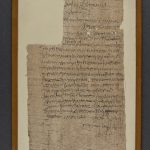| Artefact ID | 189 |
| TM ID | TM 10020 |
| Findspot (DEChriM ID) | 50 (Qaṣr Qārūn) | Class | Textual |
| Material | Papyrus |
| Writing medium | Sheet/roll |
| Text content | Documentary |
| Language | Greek |
| Archive/Dossier | Archive |
| Description | P.Abinn. 18, P.Lond. II 408: Letter to Abinnaeus. Chaeremon, a magistrate of the metropolis of the Arsinoite, protests vigorously (μὰ τὸν γὰρ θεὸν, "by God") to Abinnaeus against the conscription of individuals and misappropriation of property in the village of Theoxenis committed by the soldiers Abinnaeus had sent there. On the question of whether Abinnaeus, commander of the cavalry (praefectus alae) in Dionysias, was a Christian and for his relationship with monks and clergy, see Bell et al. 1962: 32-33, Barnes 1985: 373-374, Choat 2006: passim, Luijendijk 2008: 35, n. 42, Kaiser 2015: 383, Choat 2017: 47. Recto: cursive hand; Chaeremon's signature in another hand; text written along the fibres. |
| Selection criteria | Christian terms/formulas/concepts |
| Date from | 342 |
| Date to | 351 |
| Dating criteria | Dated to ca. 346 in ed. pr. According to Gallazzi (2015: 177-178), all of the dated texts of Abinnaeus archive are dated between 343 and 351 AD, that is, in the period in which Abinnaeus exercised his functions of praepositus of the castra (342-351). |
| Absolute/relative date | Relative date |
| Archaeological context | Purchased as part of a lot comprising Papyri 401-447 from the Reverend Chauncey Murch (b. 1856, d. 1907) on 15 May 1893 (British library website). While it was previously thought that Fl. Abinnaeus' archive was found in Philadelpheia, where he went to live after his retirement, Gallazzi 2015 argued that Fl. Abinnaeus should have left his papers in his office (or in his lodgings), in Dionysias, when he left the army and handed over the command of the castra to others. The material would have been recovered in Qaṣr Qārūn, at the end of the nineteenth century, by antiquities seekers or sebâkh quarrymen and given to merchants of Madīnat al-Fayyūm, where they would have been intermingled with the documents recovered at Kūm al-Ḫarāba al-Kabīr Ğirza (Philadelpheia), before reaching European collections. |
| Accession number | London, British Library, Pap 408 |


 Json data
Json data




